Copyright
©2014 Baishideng Publishing Group Inc.
World J Gastroenterol. Jul 14, 2014; 20(26): 8351-8363
Published online Jul 14, 2014. doi: 10.3748/wjg.v20.i26.8351
Published online Jul 14, 2014. doi: 10.3748/wjg.v20.i26.8351
Figure 1 Mechanisms linking nonalcoholic fatty liver disease to polycystic ovary syndrome.
Obesity and insulin resistance, features highly prevalent in polycystic ovary syndrome (PCOS) patients and hyperandrogenism, a predominant characteristic of PCOS, as contributing factors to the development of nonalcoholic fatty liver disease (NAFLD). Hyperandrogenism may exert direct effects on the liver and indirect effects by modulating insulin sensitivity and favoring visceral adiposity. Insulin resistance/hyperinsulinemia contributes to hyperandrogenism by affecting the production, the clearance and bioavailability of ovarian androgens.
- Citation: Vassilatou E. Nonalcoholic fatty liver disease and polycystic ovary syndrome. World J Gastroenterol 2014; 20(26): 8351-8363
- URL: https://www.wjgnet.com/1007-9327/full/v20/i26/8351.htm
- DOI: https://dx.doi.org/10.3748/wjg.v20.i26.8351













